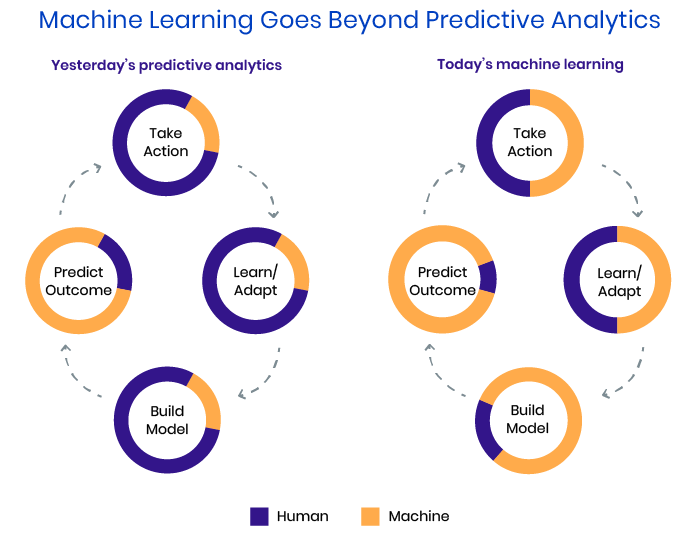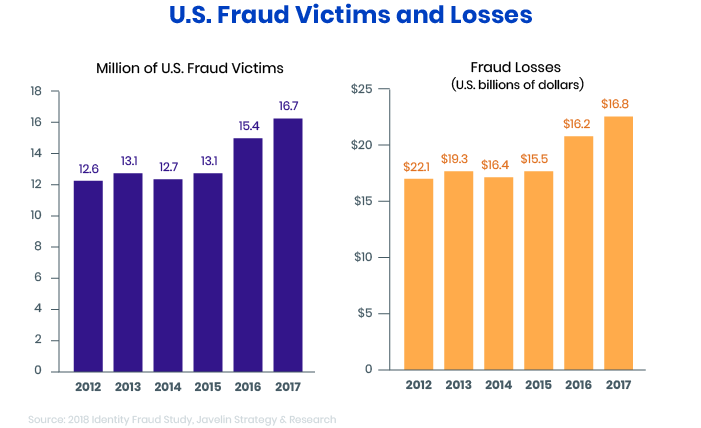7 Exciting Uses of Machine Learning in FinTech
https://rubygarage.org/blog/machine-learning-in-fintech
Machine learning (ML) has moved from the periphery to the very center of the technology boom. But which industry is best positioned - with the huge data sets and resources - to take advantage of machine learning? According to research by PwC, this industry is finance.
Machine learning can significantly contribute to your FinTech project’s success by increasing data protection and customer engagement, among other things. In this article, we review the most prominent use cases of machine learning in FinTech and provide examples.
#1 Algorithmic trading
Algorithmic trading isn’t new, but it’s still a very effective strategy that many financial companies use to automate their financial decisions and increase trades. According to Techfunnel, 73 percent of daily trading worldwide is carried out by machines in 2017. Almost every major financial company invests in algorithmic trading as the frequency of trades executed by machine learning technology is impossible to replicate manually.
The following table shows the difference between manual and algorithmic trading:
| Algorithmic trading | Manual trading |
|---|---|
| Free of emotions | Involves human emotions |
| Rules are pre-defined | No predefined rules |
| No need to monitor the market | Need to monitor the market all the time |
| Slippage reduces considerably | May lead to heavy slippages |
Bank of America has launched BofAML Express, a high-frequency trading platform. The capabilities of the platform are expected to be used not only by algorithmic traders but also by less technology-savvy customers. The platform’s activity is estimated to account for 2 to 3 percent of average daily US stock trading.
#2 Machine learning goes beyond predictive analytics
Many financial organizations today have moved from using traditional predictive analysis to using machine learning algorithms to forecast financial trends. With the help of machine learning, financial specialists can identify market changes much earlier than with traditional methods.

In the financial services industry, machine learning algorithms can predict market risk, reduce fraud, and identify future opportunities.
Machine learning technology is able to reduce financial risks in several ways:
- Machine learning algorithms are able to continuously analyze huge amounts of data (for example, on loan repayments, car accidents, or company stocks) and predict trends that can impact lending and insurance.
- Machine learning can also be applied to early warning systems. ML-enhanced early warning systems can be used by banks and other financial institutions to predict anomalies, reduce risk cases, monitor portfolios, and provide recommendations on what to do in cases of fraud.
#3 Fraud prevention and detection
With more technological innovations there are more risks of fraudulent transactions for financial organizations. The financial services industry is suffering from fraud-related losses more than any other industry. Almost 17 million organizations and customers in the US have experienced fraud according to Javelin’s 2018 Identity Fraud Report.

The financial industry takes two approaches to fraud detection and prevention: a rules-based approach (which requires manual work and human supervision) and a machine learning-based approach. In recent years, the financial services industry has been moving to ML-based approaches to detect fraudulent activity. Let’s look closer at the core features of these two approaches and clarify the benefits of machine learning.
| Rules-based approach | ML-based approach |
|---|---|
| Long-term processing | Real-time processing |
| Requires much manual work | Automatic detection of all possible anomalies |
| Multiple verification steps that harm the user experience | Reduced number of verification measures |
| Catches obvious fraudulent activities | Finds hidden fraudulent activities |
Below are some financial fields where machine learning is used for fraud detection.
Insurance
Fraudsters steal $80 billion a year across all branches of insurance according to the Coalition Against Insurance Fraud. Machine learning systems can detect unusual behavior, or anomalies, and flag them. Algorithms not only give detailed information on suspicious behavior but even suggest measures that can be taken to resolve situations and protect programs.
Banking
Electronic payments are extremely vulnerable to fraud. In banking, machine learning can delay potentially fraudulent transactions until a human makes a decision. Unlike humans, machines can weigh the details of a transaction and analyze huge amounts of data in seconds to identify unusual behavior.
Machine learning technologies are also used by banks for biometric user authentication. For example, ZOLOZ company has developed a technology using machine learning algorithms that makes it possible to use selfies to ensure the security of financial operations. The company’s Optical character recognition identifies a user by veins in the white of the eye and other unique eye features.
#4 Better targeting
According to recent research by L’atelier BNP Paribas, Millennials value transparency and convenience when dealing with financial services. They demand personalized services at their fingertips. The FinTech industry is trying to attract Millennials, a technology-savvy generation, with new technological trends. For instance, financial institutions are working on using machine learning technology and big data to replace human advisors with robotic advisors. Robo-advisors can not only attract Millennials but also eliminate a huge amount of processing costs for financial institutions.
For example, the Mylo FinTech app is using machine learning technologies to make it easier for Millenials to incorporate saving and investing into their daily habits. Upstart also considers Millennials an important market segment and uses machine learning to automate and facilitate borrowing.
#5 Better customer support
The times when bank clients stood in lines are over. With the help of modern technologies, banks and other financial institutions can make their services digital. Let’s have a closer look at examples of how machine learning can be applied to customer support:
Chatbots
Forrester research shows that 77 percent of bank clients in the United States consider saving customer time to be the most valuable aspect of good service.
By using technology like chatbots, machine learning helps financial institutions to solve customer issues immediately. For example, Bank of America introduced their Erica chatbot to provide customers with instant information about balances, transactions, and other related matters. Chatbots are beneficial in banking because they save money, increase customer engagement, and streamline customer support.
Personalized experience
Personalization is the key to building customer loyalty and trust toward any business or organization. Especially when dealing with finances, people value transparency and deep relationships with an institution they’ve chosen.
Machine learning algorithms can analyze customers’ data and predict what services they might like or give helpful advice. For example, Capital One has launched the Capital One Second Look program that can monitor expense patterns. After detailed analysis, this program can detect if a customer has been charged twice for the same product or service and notify them about it. Or it can analyze what tips the customer usually leaves at a restaurant and alert them if they’re overly generous. Programs like this make customers feel valued and motivate them to stay with a financial institution.
Sentiment analysis
Sentiment analysis, also called opinion mining, is a process of analyzing customers’ emotions, opinions, and attitudes toward other individuals, products, or services. In the financial industry, institutions use machine learning algorithms to analyze financial news from different sources and make predictions of possible stock market trends. The advantage of using technology for sentiment analysis lies in the ability to process huge amounts of data from different news channels in seconds.
So how exactly does this technology work? Sentiment analysis applications are programmed to classify all information as positive, negative, or neutral. For example, the words increase, growth, and successful can be defined as positive, while fall and risk are defined as negative. Based on this analysis, the technology makes predictions about financial trends.
#6 Help with underwriting services
Underwriting is the process of assessing risks that might be faced by an individual or company that wants to apply for life insurance or a loan, for example. But what if applicants purposely omit vital information about themselves or there’s no information about previous insurance deals? That’s where machine learning comes into play. Natural language processing (NLP) algorithms help financiers to better evaluate applicants by searching for personal information on social media, for example.
Machine learning algorithms can assess and predict the underlying insurance or loan trends that can influence the finance industry in future.
#7 Prediction of stock market changes
Everyone wants to trade smartly, especially in the stock market. The stock market is regarded as one of the best investment decisions in the twenty-first century. But how can you know which stocks are going to increase and which aren’t?
Machine learning technology analyzes past and real-time data about companies and predicts the future value of stocks based on this information. In addition, machine learning algorithms can even hunt for news from different sources to collect any data relevant to stock predictions.
The future of machine learning in the finance industry
It’s obvious that chatbots and robo-advisors are growing trends in the finance industry. But some financial institutions are predicting even more seamless communication with customers.
For example, Kasisto is already creating a chatbot that will be able to answer not only usual questions about balances and spending but also questions about customer’s past buying decisions and experiences.
It’s also possible that financial service providers will not only use chat functionality but also voice recognition. Customers will probably forget about irritating usernames and passwords to log in to their accounts as there will be facial and voice recognition or other methods of biometric authentication.
Wrapping up
Machine learning is playing an important role in the FinTech industry and is going to show even more potential in the future. Taking into account all use cases given above, it seems clear that machine learning algorithms are beneficial for financial institutions.
Feel free to start discussing FinTech trends in the comments below.
7 Exciting Uses of Machine Learning in FinTech的更多相关文章
- ON THE EVOLUTION OF MACHINE LEARNING: FROM LINEAR MODELS TO NEURAL NETWORKS
ON THE EVOLUTION OF MACHINE LEARNING: FROM LINEAR MODELS TO NEURAL NETWORKS We recently interviewed ...
- Teaching Your Computer To Play Super Mario Bros. – A Fork of the Google DeepMind Atari Machine Learning Project
Teaching Your Computer To Play Super Mario Bros. – A Fork of the Google DeepMind Atari Machine Learn ...
- Azure Machine Learning
About me In my spare time, I love learning new technologies and going to hackathons. Our hackathon p ...
- How do I learn machine learning?
https://www.quora.com/How-do-I-learn-machine-learning-1?redirected_qid=6578644 How Can I Learn X? ...
- (转)Is attacking machine learning easier than defending it?
转自:http://www.cleverhans.io/security/privacy/ml/2017/02/15/why-attacking-machine-learning-is-easier- ...
- Brief History of Machine Learning
Brief History of Machine Learning My subjective ML timeline Since the initial standpoint of science, ...
- How do I learn mathematics for machine learning?
https://www.quora.com/How-do-I-learn-mathematics-for-machine-learning How do I learn mathematics f ...
- 机器学习简史brief history of machine learning
BRIEF HISTORY OF MACHINE LEARNING My subjective ML timeline (click for larger) Since the initial sta ...
- Lessons learned developing a practical large scale machine learning system
原文:http://googleresearch.blogspot.jp/2010/04/lessons-learned-developing-practical.html Lessons learn ...
随机推荐
- boostrap --- 弹窗modal的使用
<input id="btntext" type="button" value="添加文本组件" data-toggle=" ...
- json数据转换成结构体
package main import ( "encoding/json" "fmt" ) type IT1 struct { Company string ` ...
- Python中的赋值、深拷贝与浅拷贝(内存地址)
Python中的赋值.深拷贝与浅拷贝(内存地址) 1.python中的可变对象与不可变对象 (1) 可变对象:dict,list def dict_test(): a = {} b = a print ...
- Loadrunner 进行压力测试 并发测试
问题背景: 今年公司项目进行Saas化转型,在中间遇到很多问题,其中之一就是 Saas化后多租户的性能 和 并发问题.公司让我来调研和重现问题,通过调研总结了一些经验教训,分享给大家. 环境: Loa ...
- 性能对比:aelf智能合约运行环境性能是evm的1000倍
测试用例及代码库 机器配置 测试结果 3.1 EVM 3.2 AElf 3.2.1 LoopDivAdd10M 3.2.2 LoopExpNop1M 测试结论 近期对标以太坊做了一系列针对测试,在此次 ...
- Jmockit 构造函数与初始代码块
from Jmockit 中文网 http://jmockit.cn/showArticle.htm?channel=4&id=14 有些编写不良好的类的构造函数,初始代码块,静态代码块存在大 ...
- Vue.js 源码分析(二十三) 指令篇 v-show指令详解
v-show的作用是将表达式值转换为布尔值,根据该布尔值的真假来显示/隐藏切换元素,它是通过切换元素的display这个css属性值来实现的,例如: <!DOCTYPE html> < ...
- Python term 模块
Python term 模块 term 模块适用于文字编辑,样式切换,光标移动 等一系列操作适用于终端命令行文字光标处理等操作. 安装 pip install py-term 使用方式 方式一 imp ...
- 锁定文件失败,打不开磁盘“D:\biehl\centos\taotao\taotao-dubbo-register\CentOS-000001.vmdk”或它所依赖的某个快照磁盘。模块“Disk”启动失败。未能启动虚拟机
1.锁定文件失败,打不开磁盘“D:\biehl\centos\taotao\taotao-dubbo-register\CentOS-000001.vmdk”或它所依赖的某个快照磁盘.模块“Disk” ...
- python网络编程-2
1.理解相关概念 #浅显理解下 对比cpu与io的差距如:io从硬盘读取一条数据9ms ,cpu在9ms可以做450万次指令 cpu切换上下文的方式:1.遇到io操作切换cpu 2.cpu时间片分配 ...
